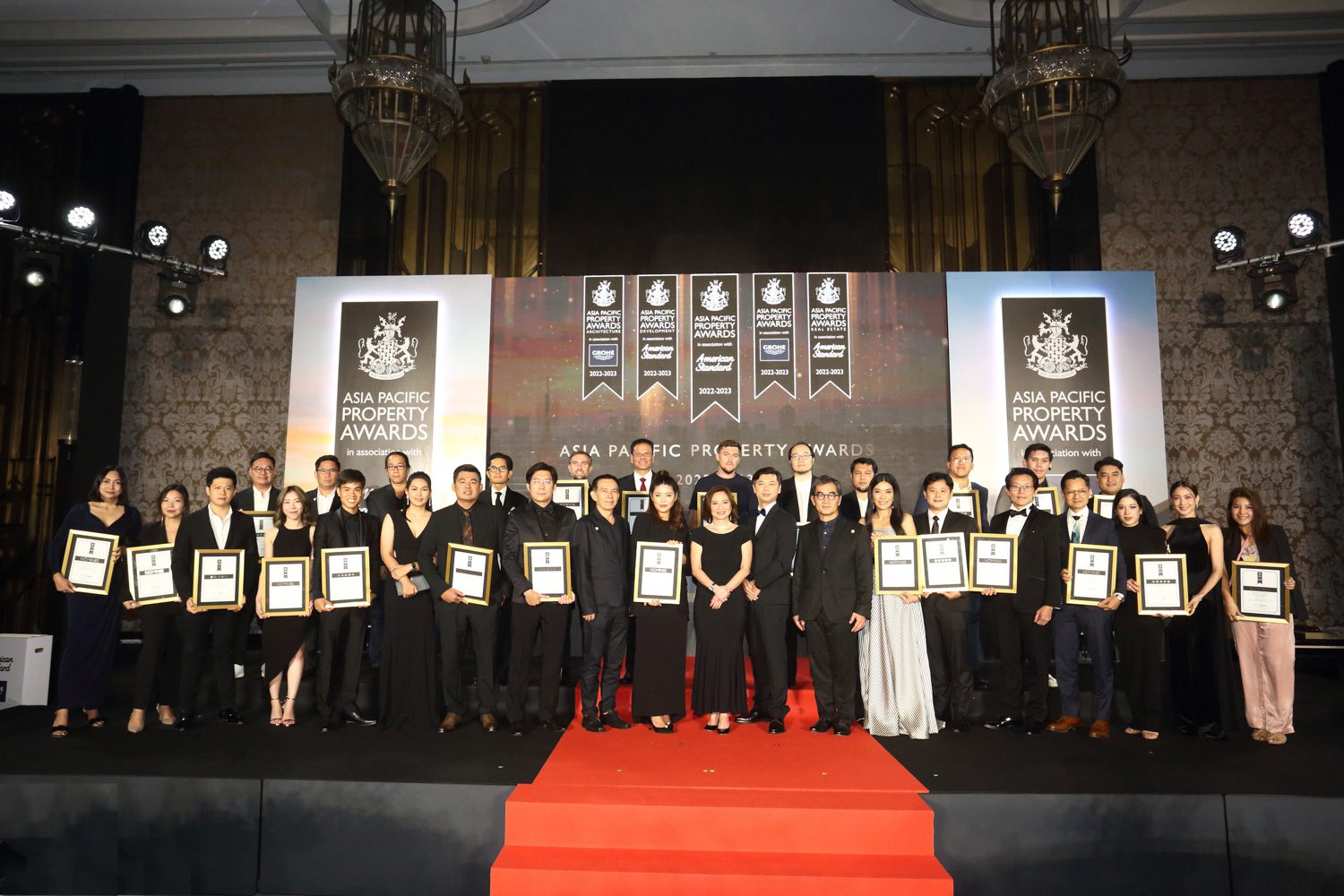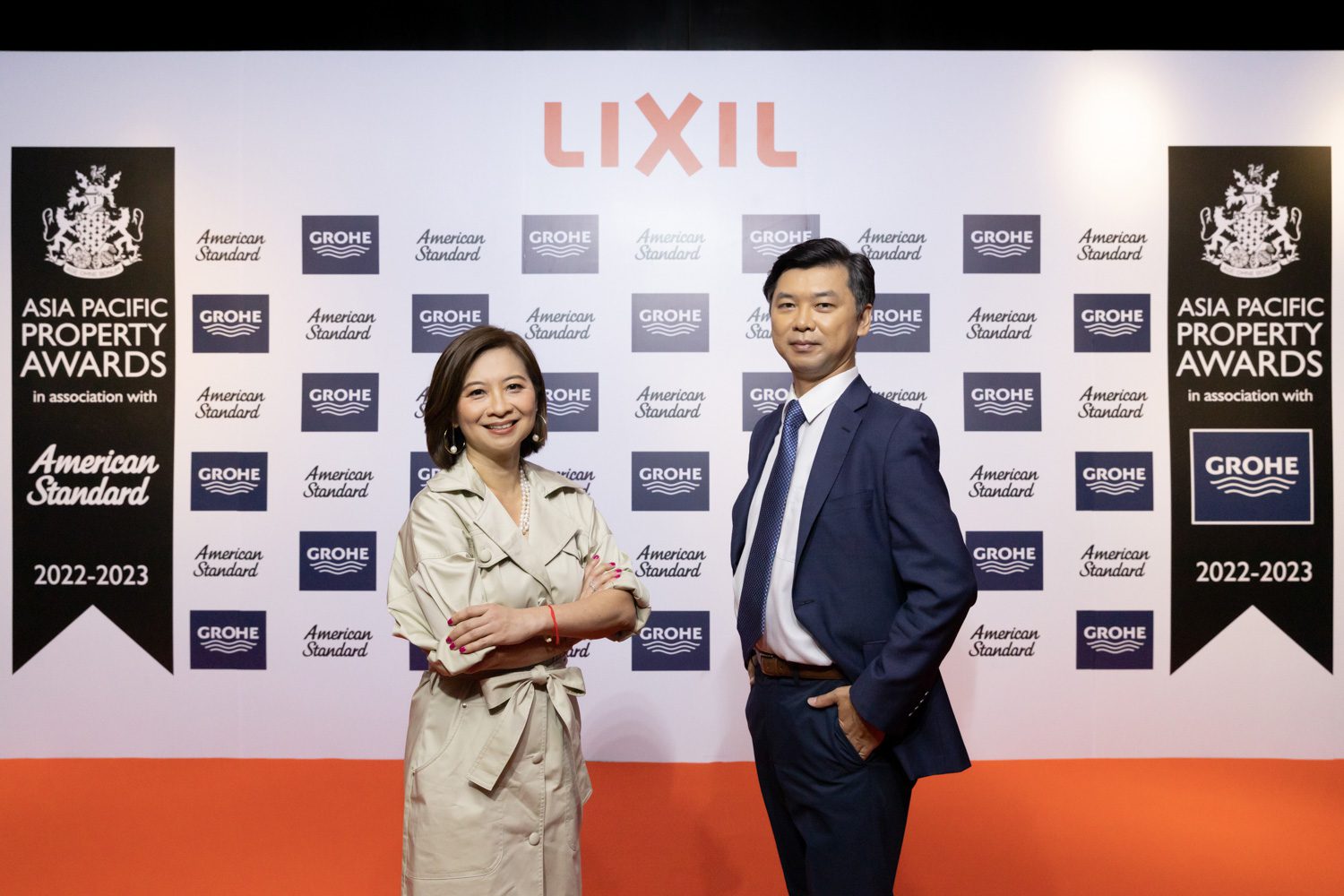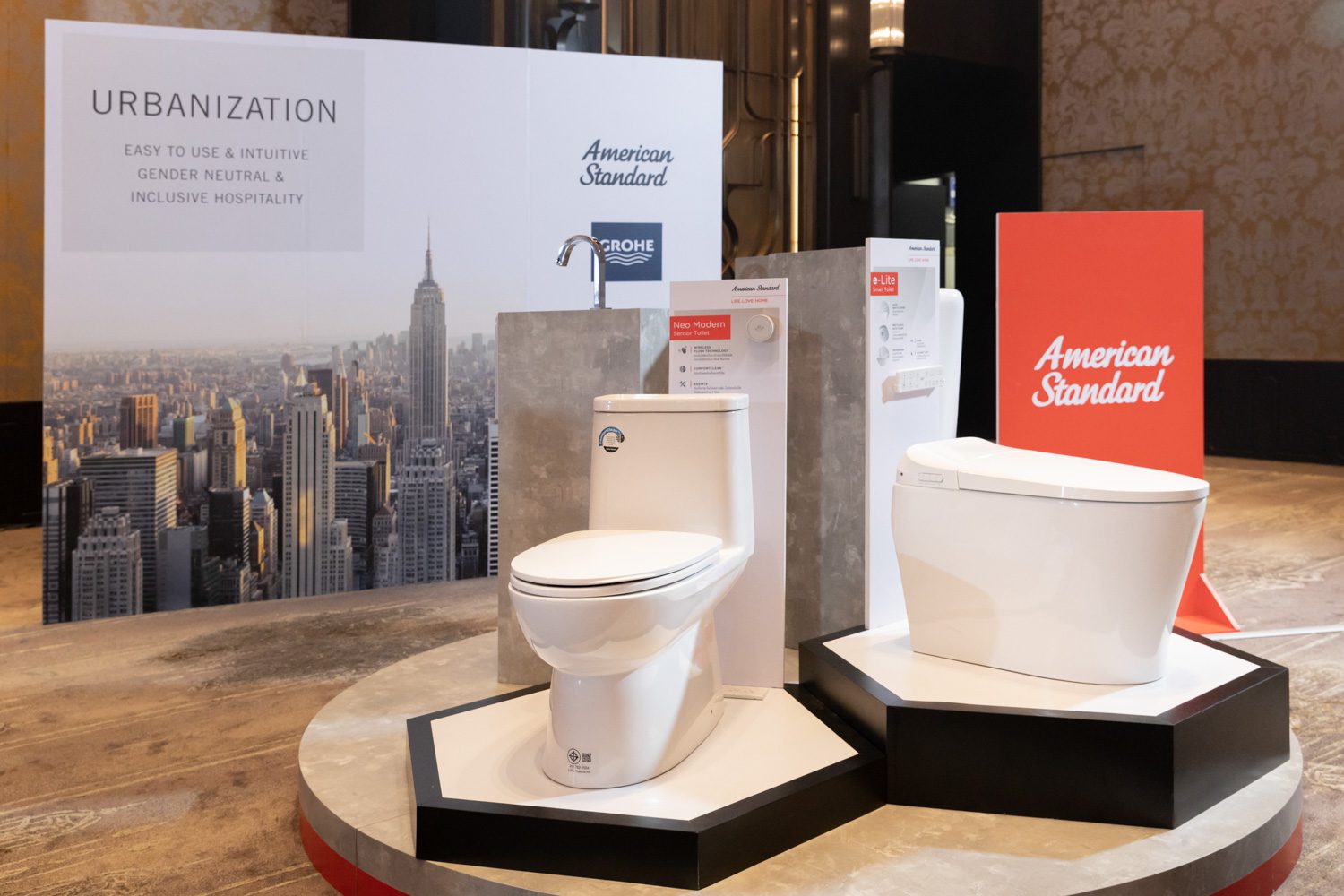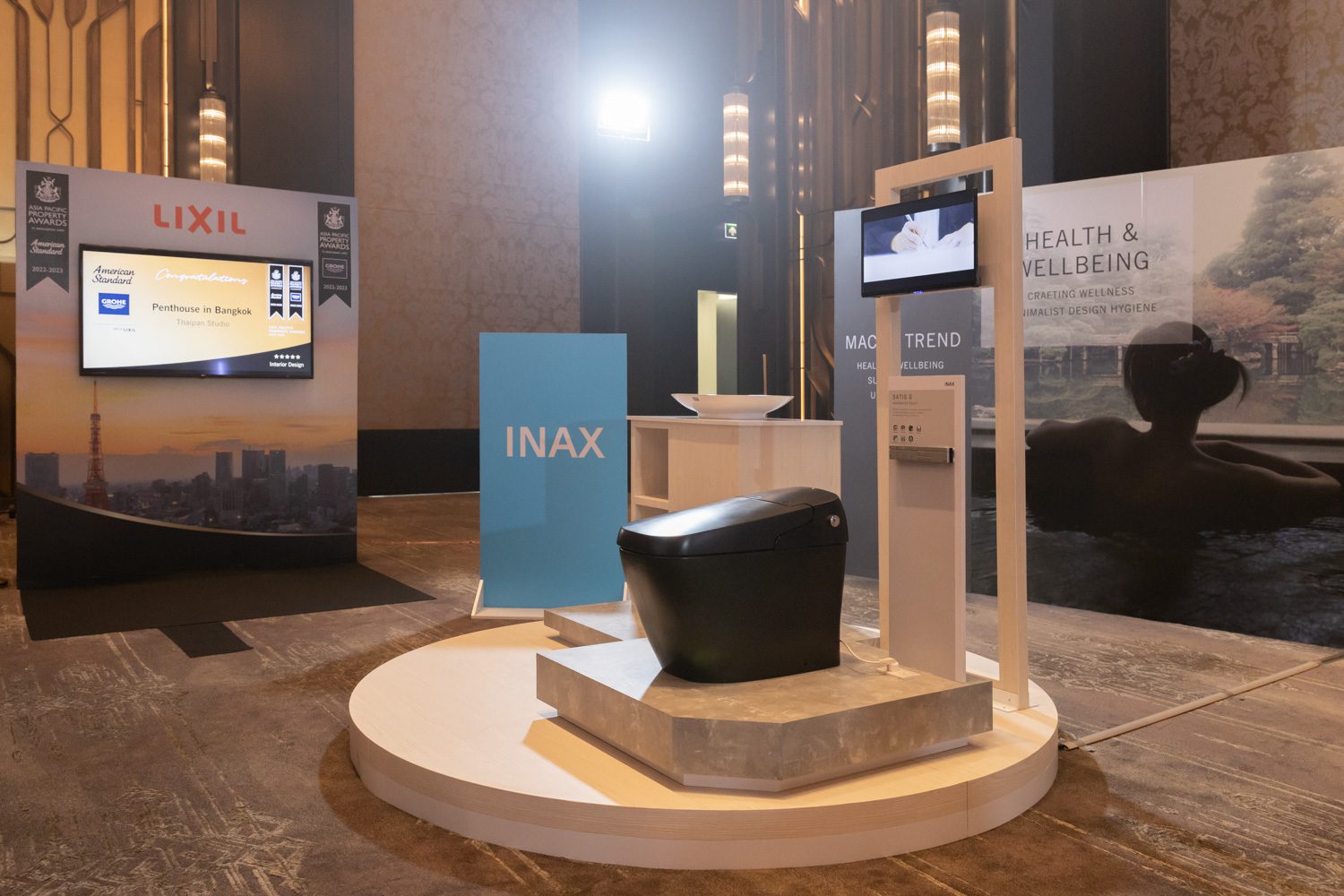
Asia Pacific Property Awards 2022-2023, Five Star Group Photo | Photo courtesy of LIXIL
ART4D SPEAKS TO MR. SATOSHI KONAGAI, LEADER, LIXIL WATER TECHNOLOGY APAC AND MS. AUDREY YEO, LEADER, THAILAND, LIXIL WATER TECHNOLOGY APAC ABOUT THIS LATEST COLLABORATION IN WHICH THEY SHARE THE COMMON GOAL IN DRIVING VALUABLE DESIGNERS TO GO FURTHER
TEXT: KARJVIT RIRERMVANICH
PHOTO: KETSIREE WONGWAN EXCEPT AS NOTED
(For Thai, press here)
LIXIL has extended their main sponsorship for the International Property Awards and the Asia Pacific Property Awards for another 3 years. art4d have had an opportunity to have a conversation with Mr. Satoshi Konagai, Leader, LIXIL Water Technology APAC and Ms. Audrey Yeo, Leader, Thailand, LIXIL Water Technology APAC, before the award ceremony which was held at Waldorf Astoria Bangkok on the night of 19th August 2022 about this strengthen partnership for years to come.

(Left) Audrey Yeo, Leader, Thailand, LIXIL Water Technology APAC (Right) Satoshi Konagai, Leader, LIXIL Water Technology APAC
art4d: There are a lot of architectural design and property awards in the industry nowadays, locally, regionally and globally. What do you think makes the Asia Pacific Property Awards and the IPA (International Property Awards) stand out? What impact can you see it making in the world where awards are ubiquitous?
Satoshi Konagai: International Property Awards is one of the highest luxury award on a global level. Now there are over 100 well known judges evaluating many applicants not only from Asia-Pacific but from all around the world. From that perspective, I think LIXIL sees three key values especially for our designers, architects and developers in Asia. One is the ‘reward’, the IPA winner definitely gets the reward with global prestige. The next one is the ‘promotion’. Since the IPA is a global platform and the winner would get to enjoy the promotion across social media or any other from of media globally. Then the last point is credibility, IPA is not only well known in this industry but also the financial industry and many investors consider whether this property or developer or this designer is awarded IPA or not. This is great credibility for Asian developers, designers and architects because if they win the IPA awards, it will mean that they are industry leaders within this real-estate industry. That’s why we are selective on IPA strategy partners, and that is a global perspective.

Audrey Yeo: To add to what Satoshi San has said, IPA has also got many regional awards from Africa to Canada, US, UK, there’s almost about 10 regions and in Asia-Pacific alone we received about 1200 entries. I’m very happy to say that Thailand actually makes up one of the highest entries after China. Thailand alone has about 25% participation and if we translate to winners, it also has the highest number of award winners from this. It does show that the value has been appreciated from this level of participation. Those in the industry do see the opportunity that they have from being part of the recipients of this award, not only in Thailand or regionally but also internationally.
We will be presenting the Asia Pacific Property awards category winners tonight at the ceremony. Apart from this, there is also another group of winners that we call ‘the nominees’ who will now compete on an international level at the IPA. This is why we value being the main sponsor for this award because it does give a lot of leverage for the industry leaders to really expose themselves at the international level.


Asia Pacific Property Awards 2022-2023, Award Winner Group Photo | Photo courtesy of LIXIL
art4d: As you have mentioned, this year Thailand came 2nd in terms of amounts of awards received, only second to China where the number of entries must have been a lot more. What do you think are the key characteristics or differences from entries from other countries which makes entries from Thailand appealing?
SK: I would say Thailand is an important country with design excellence on many levels and perspectives. It’s positioned in the center of Asia as a meeting point with great, creative and innovative ideas, so I’ve seen many of those ideas come from Thailand, especially in the real-estate industry. As you know, Thailand has many good design schools, that’s why some of the well-known international designers set up their branches here to get more talented people from Thailand. This is actually evidence that Thailand is one of the markets that is driving the architecture and design trends in the real estate industry.
AY: Adding from a local perspective, what we also saw was that in Thailand, a lot of key developers, designers, interiors are also internationally recognized because if you look at a lot of the projects in Thailand, they are actually very well thought through projects. I’ll give you an example,the developer group MQDC, they are very focused on sustainability and really ensure that the whole project delivers towards that direction and it gets a lot of international recognition.
On top of this, recently American Standard launched the design award for students called ‘American Standard Design Awards’ or the ASDA, targeting students at universities and inviting them to participate in designing bathroom space in hospitality as well as residential projects.
This award is also launched in Asia-Pacific levels, not only in Thailand and I must say that again, we have made highlights. This is because the winner of the Thailand awards, Khun Teeragiat from Assumption University, has also later brought home the Asia Pacific awards. We do see that there is a lot of strong foundation that has been built to develop the design and architecture industry, which is why in the longer run, Thailand is set in a very good position to get more of the projects and recognition internationally.

Passive Cleaned Toilet The most cleaned toilet by Teeragiat Sukyoo l Photo courtesy of ASDA 2022
art4d: Hopefully we will beat China next year (laughs)
AY: You never know, right? With the talent pool we have in Thailand, why not?
art4d: LIXIL will be the awards partner for years to come. What does LIXIL aim to promote, raise awareness or provoke through this partnership?
SK: Since LIXIL is a purposeful-driven company, we have the responsibility to deliver the value, gross profit but purpose is the most important. So I see the IPA as an opportunity to add value for designers, architects and developers in Asia. As I have already mentioned, the rewards, promotion and credibility. Also, LIXIL is consumer-centric company and through the IPA platform, we are also promoting consumer needs. Today we will have a session at night where we are sharing macro-trends, with the first being ‘health and well-being’, the second ‘sustainability’ and the third is ‘urbanization’. We have been observing these three trends across global industries and also in Asia. I’ll share one example, for health and well-being, people are staying home more and more and my wife for example, she spends almost one hour every night in the bathroom to relax from everyday stress. A bathroom is not anymore only a functional space, but also a place to relax and bring comfort, like a home spa. So she requested me to upgrade the shower because she wants more comfort (laughs). The point is that this is definitely a trend, so our company as a leading technological firm have the responsibility to observe these kinds of trends and then to announce, promote and work together with stakeholders like developers or designers. I think that answers your question.

AY: A lot of things right now are driven by these three macro overviews. Part of the opportunities we see, a big part of this IPA platform is we are able to network with the stakeholders across different fields whether it be architecture, real estate, public developers to really understand how we look at the future. Right now we don’t talk about the plan for 1 to 2 years, we tend to think 5 years ahead asking, what is going to be the trend in the next five years. For example, if we look at urbanization, it is now a key topic. People are concerned about living spaces and properties and condominiums are becoming smaller. In this instance, we have the opportunity to engage with some of these partners in terms of how we design homes. In those days, there was always a wall between the kitchen and living room also between bedroom and bathroom, they were compartmentalized. But today, those walls are continuing to disappear from the design so your kitchen is now an open space – for two reasons, there’s not enough space (laughs) so the architect needs to think of a way to create more space and secondly it becomes a place for socializing, people start to socialize in the kitchen so you don’t want the space to be a box but rather to open up the space. When we talk about urbanization, this is where we look at the bathroom and bedroom and think about how to make products that look appealing so that people feel proud to show their bathroom as well and what types of product solutions would fit into the different design trends. This is an opportunity we see as a brand, LIXIL, working with all these stakeholders to create more value to our partners in terms of looking at future trends.

SK: Another important thing is that sustainability is not just a buzzword but an area we really need to tackle. Singapore, as you know, the hotel association announced that all hotels in Singapore have to reduce half of water consumption by 2030. Normally one room in a hotel spends 700 litres per day, let’s say with two parents and two children and half of the use is from showering. The immediate solution would be to ask to guests to stop taking a shower (laughs), but of course as you know, they cannot do that since it’s a part of our lives and its important to relax. So now they are considering how to manage this government direction without compromising customer’s benefits. This is already the current trend. We are working together with developers and the government on how to minimize water consumption, that’s an example of sustainability.
AY: I think sustainability is a huge topic now, hotels are one area where we know there are fundamental needs but if you look at commercial buildings today, you may have heard of LEED requirements and they even now have different levels. It’s about how you can achieve the rating to be certified as a LEED building, so that demand and the needs are there. This is where LIXIL, through our strength and R&D, we globally position ourselves so we can really understand the needs of our customers and working with them to find out how to help achieve the standard or the requirement they need. For commercial buildings today, when we talk to new commercial building owners, we don’t just talk about products, we discuss about how do we help them to achieve the LEED standard based on the entire bathroom space and think about what kind of product solution can we bring to them to help them achieve their standard. This is where we come in as a consultant, our position is no longer only as a product supplier.


